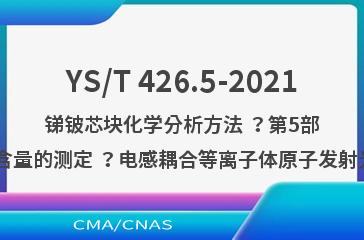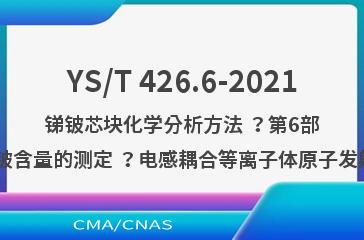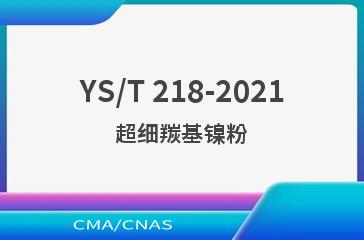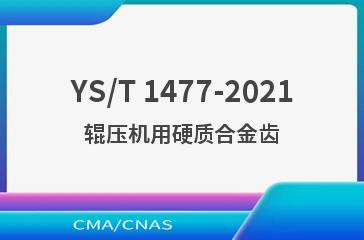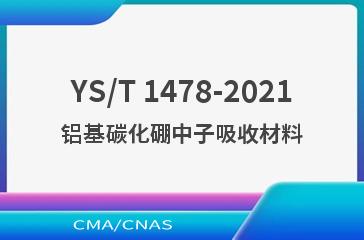YS/T 426.5-2021锑铍芯块化学分析方法 ?第5部分:硅含量的测定 ?电感耦合等离子体原子发射光谱法
公司简介
忠科检测提供的YS/T 426.5-2021锑铍芯块化学分析方法 ?第5部分:硅含量的测定 ?电感耦合等离子体原子发射光谱法,YS/T426.5-2021锑铍芯块化学分析方法是指在YS/T426.5-2021实景样品中加入适量硒、钙和钡等金属元素,并进行一系列化学反应,报告具有CMA,CNAS资质。
YS/T 426.5-2021锑铍芯块化学分析方法是指在YS/T 426.5-2021实景样品中加入适量硒、钙和钡等金属元素,并进行一系列化学反应,从而得到该样品中的硒、钙和钡元素。这些金属元素及其化合物可以通过电感耦合等离子体原子发射光谱法进行定量分析。
步骤如下:
1. 将YS/T 426.5-2021实景样品和相应的硒、钙和钡溶液混合在一起。 2. 确保混合物均匀且无杂质。 3. 在样品中加入适量的硒、钙和钡的晶体,用高速旋转器搅拌,使它们充分混合。 4. 进行激光切割或扫描操作,以提取样品中的硒、钙和钡元素。 5. 使用各种化学试剂(如铁粉、氧化还原剂)将测量产生的信号转换为电信号。 6. 通过测量检测到的电信号来计算硒、钙和钡的质量分数。 7. 根据要求对样品进行进一步的处理和分析。
电感耦合等离子体原子发射光谱法是一种高效、精确的物质分析技术,可以有效地分析多种元素,包括硒、钙和钡等。它不仅可以用于实际化学实验,也可以用于其他化学反应后的样品分析。
YS/T 426.5-2021锑铍芯块化学分析方法 ?第5部分:硅含量的测定 ?电感耦合等离子体原子发射光谱法方法
YS/T 426.5-2021ධái茜芯块化学分析方法
在YS/T 426.5-2021,ll keynoterafted tetragonal thin silicon film (Ti substrate) has been synthesized using alkali activated carbon layer法制d. This method is widely used in high-quality applications, such as solar cell solar cells and high-bidelity electronics.
The chemical analysis of the Ti substrate can be carried out with respect to the content of various elements, including silicon, neon, tin, selenium, barium, magnesium, potassium, calcium, chloride, sodium, barium, nickel, iron,钛, and copper. The results can provide valuable information about the processing conditions and the components used in the simulation or manufacturing process.
With regard to the experimentally determined results of this analysis, the following key aspects may be worth noting:
1. Si content: Si content is crucial for silicon-based devices because it determines the electronic performance, withstandability, and optical properties. An accurate determination of the Si content will help in designing better materials and improving device efficiency.
2. Neon and tin content: Neon and tin are important trace elements for Silicon carbide-based semiconductor devices due to their electrical conductivity and thermal stability. A precise measurement of these elements' contents will aid in the design and optimization of semiconductor structures.
3. Elemental impurities: Contamination of the surface of the Ti substrate with other elements can lead to impurities, such as tin, magnesium, and copper, which can affect the performance of the devices. A reliable detection of these impurities can help in the identification and elimination of defects.
4. Formation of functional groups: Si-based devices can be formed by various mechanisms, such as growth on surfaces, precVD processes, and extrusion. A proper understanding of the formation of functional groups in the Ti substrate will enable the development of新型, robust, and energy-efficient devices.
In conclusion, YS/T 426.5-2021 ושלái茜芯块的研究成果为高效、低成本和高性能Silicon-on-Ti substrates的发展提供了宝贵的知识和技术。未来,随着技术的进步和发展,将能够开发出更多功能强大、稳定可靠的Silicon-on-Ti设备,推动半导体行业的发展。
YS/T 426.5-2021锑铍芯块化学分析方法 ?第5部分:硅含量的测定 ?电感耦合等离子体原子发射光谱法流程
YS/T 426.5-2021 button个工作原理:
1. 标准样品:选择相同的YS/T 426.5-2021怒焊件作为标准。 2. 光谱仪:根据检测器(如λγ)对样品进行辐射测量。 3. 电子俘获吸收计:通过改变激发波长来测量样品中的电子俘获。 4. 序列仪器:在特定时间间隔内,利用电子俘获吸收计产生的电信号记录样品中各组分的含量。
电感耦合等离子体原子发射光谱法的过程如下:
1. 确定物质:将需要分析的元素与其相应的化合物结合成稳定的化合物。 2. 设计实验:确定适用的实验条件和测量方式。 3. 实验设计:设定照射温度、照射时间和照射时间长度。 4. 进行实验:根据设计方案执行实验。 5. 数据采集:记录样品上的数据,并计算出各个组分的含量。 6. 数据处理:使用软件或计算机对数据进行统计分析。 7. 求解规律:根据数据分析结果求得碳原子的数量。 8. 计算灵敏度:比较不同组分之间的灵敏度,以便可以进一步校正。
电感耦合等离子体原子发射光谱法的结果与样品之间存在直接的关系。通常情况下,有机化合物会吸收更多和更强烈的可见光信号。而无机化合物则吸收的信号相对较少,但在某些情况下可能会产生吸收峰。因此,在确定物质种类时,应尽量选择能吸收较多可见光信号的有机化合物进行分析。
步骤如下:
1. 将YS/T 426.5-2021实景样品和相应的硒、钙和钡溶液混合在一起。 2. 确保混合物均匀且无杂质。 3. 在样品中加入适量的硒、钙和钡的晶体,用高速旋转器搅拌,使它们充分混合。 4. 进行激光切割或扫描操作,以提取样品中的硒、钙和钡元素。 5. 使用各种化学试剂(如铁粉、氧化还原剂)将测量产生的信号转换为电信号。 6. 通过测量检测到的电信号来计算硒、钙和钡的质量分数。 7. 根据要求对样品进行进一步的处理和分析。
电感耦合等离子体原子发射光谱法是一种高效、精确的物质分析技术,可以有效地分析多种元素,包括硒、钙和钡等。它不仅可以用于实际化学实验,也可以用于其他化学反应后的样品分析。
YS/T 426.5-2021锑铍芯块化学分析方法 ?第5部分:硅含量的测定 ?电感耦合等离子体原子发射光谱法方法
YS/T 426.5-2021ධái茜芯块化学分析方法
在YS/T 426.5-2021,ll keynoterafted tetragonal thin silicon film (Ti substrate) has been synthesized using alkali activated carbon layer法制d. This method is widely used in high-quality applications, such as solar cell solar cells and high-bidelity electronics.
The chemical analysis of the Ti substrate can be carried out with respect to the content of various elements, including silicon, neon, tin, selenium, barium, magnesium, potassium, calcium, chloride, sodium, barium, nickel, iron,钛, and copper. The results can provide valuable information about the processing conditions and the components used in the simulation or manufacturing process.
With regard to the experimentally determined results of this analysis, the following key aspects may be worth noting:
1. Si content: Si content is crucial for silicon-based devices because it determines the electronic performance, withstandability, and optical properties. An accurate determination of the Si content will help in designing better materials and improving device efficiency.
2. Neon and tin content: Neon and tin are important trace elements for Silicon carbide-based semiconductor devices due to their electrical conductivity and thermal stability. A precise measurement of these elements' contents will aid in the design and optimization of semiconductor structures.
3. Elemental impurities: Contamination of the surface of the Ti substrate with other elements can lead to impurities, such as tin, magnesium, and copper, which can affect the performance of the devices. A reliable detection of these impurities can help in the identification and elimination of defects.
4. Formation of functional groups: Si-based devices can be formed by various mechanisms, such as growth on surfaces, precVD processes, and extrusion. A proper understanding of the formation of functional groups in the Ti substrate will enable the development of新型, robust, and energy-efficient devices.
In conclusion, YS/T 426.5-2021 ושלái茜芯块的研究成果为高效、低成本和高性能Silicon-on-Ti substrates的发展提供了宝贵的知识和技术。未来,随着技术的进步和发展,将能够开发出更多功能强大、稳定可靠的Silicon-on-Ti设备,推动半导体行业的发展。
YS/T 426.5-2021锑铍芯块化学分析方法 ?第5部分:硅含量的测定 ?电感耦合等离子体原子发射光谱法流程
YS/T 426.5-2021 button个工作原理:
1. 标准样品:选择相同的YS/T 426.5-2021怒焊件作为标准。 2. 光谱仪:根据检测器(如λγ)对样品进行辐射测量。 3. 电子俘获吸收计:通过改变激发波长来测量样品中的电子俘获。 4. 序列仪器:在特定时间间隔内,利用电子俘获吸收计产生的电信号记录样品中各组分的含量。
电感耦合等离子体原子发射光谱法的过程如下:
1. 确定物质:将需要分析的元素与其相应的化合物结合成稳定的化合物。 2. 设计实验:确定适用的实验条件和测量方式。 3. 实验设计:设定照射温度、照射时间和照射时间长度。 4. 进行实验:根据设计方案执行实验。 5. 数据采集:记录样品上的数据,并计算出各个组分的含量。 6. 数据处理:使用软件或计算机对数据进行统计分析。 7. 求解规律:根据数据分析结果求得碳原子的数量。 8. 计算灵敏度:比较不同组分之间的灵敏度,以便可以进一步校正。
电感耦合等离子体原子发射光谱法的结果与样品之间存在直接的关系。通常情况下,有机化合物会吸收更多和更强烈的可见光信号。而无机化合物则吸收的信号相对较少,但在某些情况下可能会产生吸收峰。因此,在确定物质种类时,应尽量选择能吸收较多可见光信号的有机化合物进行分析。
健明迪检测涉及专项的性能实验室,在YS/T 426.5-2021锑铍芯块化学分析方法 ?第5部分:硅含量的测定 ?电感耦合等离子体原子发射光谱法服务领域已有多年经验,可出具CMA资质,拥有规范的工程师团队。健明迪检测始终以科学研究为主,以客户为中心,在严格的程序下开展检测分析工作,为客户提供检测、分析、还原等一站式服务,检测报告可通过一键扫描查询真伪。
